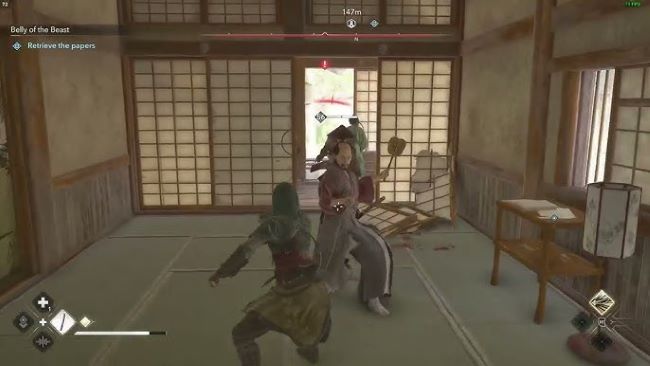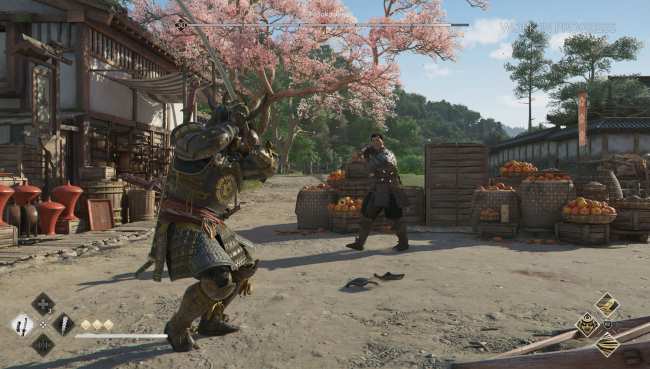Assassin’s Creed: Shadows
PS5, Xbox SeriesX/S, PC ¦ action adventureIt was German philosopher Georg Hegel who said “The only thing we learn from history is that we learn nothing from history.” Well he clearly never played an Assassin’s Creed game.
First released by Ubisoft in 2007, featuring characters at various points in history, the franchise has seen thirteen further entries since, with Assassin’s Creed: Shadows being the latest.

I told you that you could only borrow my Switch for a week!
It’s set in 16th century Japan, at the back end of the Sengoku period, with the main story focusing on Naoe, a young shinobi, and her drive for revenge when a box she was put in charge of protecting, is taken from her.
As you would expect from a game of with so many iterations, there is a familiarity that comes with playing an Assassin’s Creed; it will be comforting for those who enjoy the gameplay – as we do – while others may consider it more of the same, which in all fairness, is partly true.
There’s the open world of it all, that actually doesn’t kick in for the initial first few hours of the game, as it introduces you to the characters and the story, before letting you loose in the world.
But when you are, there are objectives to be fulfilled, areas to be explored, and of course there are viewpoints to be climbed to get an eagle’s view of the immediate area.
It’s certainly more focused towards gear and upgrading. You have a base, where you can build buildings, like a forge and dojo, and then upgrade them. The forge should be visited regularly, so whatever weapons and equipment you currently carry can be upgraded to meet your current level status, otherwise you aren’t getting the most out of them. There are trinkets and amulets that can also be collected, which improve the stats are in various ways of your weapons, outfits etc. It all starts to get a little stat heavy, especially when many just add 3% to anything, which is hardly significant. Still, it’s an addition that certainly breaks up the routine that the objectives can bring.
And then you go out into the world, and explore. And it’s quite a beautiful world at that. Ubisoft are clearly aware of the allure of Japanese culture right now, from the success of Ghost of Tsushima and the hit TV show Shōgun, and certainly lean into it with this new game.
Their Japan is quite a scenic one, made more so by the fact that it goes through the seasons, which are very noticeable when you’re playing, which makes it even more enjoyable to explore.

Now we both just stand here like this 'til one of us falls over.
The main protagonist is Naoe, who has quite an impressive skill tree that needs unlocking. Perhaps it’s a little too comprehensive, with so much to unlock, taking away from the main drive of the game, which is just going out, exploring and of course, killing.
But that’s a common theme for this iteration of the franchise, with a number of distractions from the main campaign, with some more welcome than others. The hideout, for example, that sees you having to obtain materials to upgrade various rooms within it.
At level 21, we hit a bit of an unwanted obstacle; as mentioned, it’s a good idea to upgrade your equipment to your current level status, which means returning to the hideout regularly and popping into the forge. With all the previous missions, there was never an issue of upgrading, which needs specific materials to do so, until there suddenly was.
We were in a situation where we just didn’t have the resources to upgrade certain items, specifically our weapons, which isn’t ideal when taking on more competent foes. This was noticeable on one mission in particular, an assassination of a high level enemy, who had hunkered down in an area with a number of supporting troops. Because he was so well protected, we didn’t feel confident enough to swoop in and take him out, so we did the assassin thang by taking out his entire entourage until only he was left. And yet, in a one to one battle, we still struggled to take him out, which hadn’t been an issue up until this point. So this meant that we had to take the unusual step of trying to level up on all fronts, before taking him down. Which is when we hit the upgrade problem.
If you like this style of micro-management then it isn’t that big an issue, and you could say it does add more depth to the gameplay overall, but for us it felt like it was hindering progress somewhat, which felt a little counter-intuitive to the game’s overall strategy up until this point.
So in a sense the game forces you to play it its way, as opposed to yours. Another example of this would be upgrading your skills. You can’t just upgrade when you reach certain levelling up points, instead they’re tied to knowledge points, which can be attained from visiting temples. There will be things like praying at certain areas within it, or recovering lost pages, neither of which are that complex, but again take away from your time of doing other things, but need to be done to lift the cap placed on your skills.
That said, it hasn’t stopped us from playing, especially as we had already invest over 60 hours into the game by this stage. You learn to accept the direction it pushes you in from time to time, if not fully embrace it.
One of the more welcome new elements has to be that of the addition of a new playable character.
At one point in the game you get to play Yasuke, an African samurai. He has his own storyline which you can follow, which is minor when compared to Naoe’s, but broadens the gameplay when he is around as he has a totally different skill set to hers.
This of course doubles the amount of levelling up you have to do, as his particular weaponry, outfits etc all have to be levelled up separately. This means you have to be even more careful with your resources. Or not. We chose to just focus on Naoe, and level up Yasuke when we could.
But despite all these niggles and nags, it’s still at its core an Assassin’s Creed game.
The world is a sumptuous one, made even more so with the changing of the seasons, as you travel around on foot and horse. And there is so much to explore, from towns to villages, then down a winding path to see a spectacular waterfall. And it won’t be long before you find a task of some kind, like helping out a farmer who is being targeted by bandits, or a castle that needs to have some key warriors taken out before you can open up a chest.
And then of course you have the main campaign, which sees Naoe often in the shadows, sneaking around, trying to take out as many foes as silently as possible.
For all the skills to be unlocked in the skill tree, and the various weapons and outfits that you will discover to aid you, possibly the most important asset in your arsenal is still the humble whistle. Find somewhere secluded by some enemies and use it, and they’re bound to be curious enough to investigate. This technique has been by far our most effective method of killing, made more so if you can poison the bodies you leave behind that can infect other curious soldiers.
Ubisoft have come under some criticism over the years, with many believing that this franchise, as well as some of their others such as Far Cry, are just too formulaic. And yes, if you’re familiar with the series to date, you know what to expect, but you can say that about any other franchise.
The fact is, Ubisoft put a lot into making these Assassin’s Creed games an experience, and that’s exactly what you get here.
The central themes and gameplay are just what you expect, and as fans of the series, you would hope they wouldn’t tinker around with it too much. And not everyone will be a fan of the additions, like building up your hideout, but there’s no denying they add an extra level of depth to the game, as well as help give this iteration of the game its own identity.
With its gorgeous setting, interesting characters, compelling stories and side quests, and myriad of weapons and outfits to choose that will help with your particular gameplay style, Assassin’s Creed: Shadows is an outstanding entry in the series that if you’re a fan, makes it a killer, must have title, to have in your collection.
